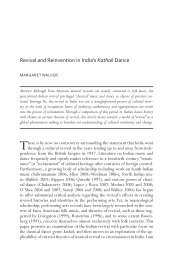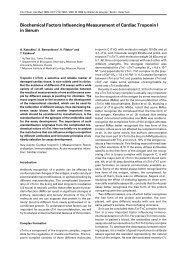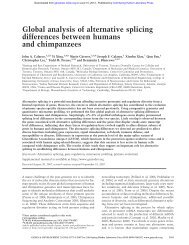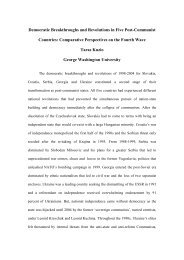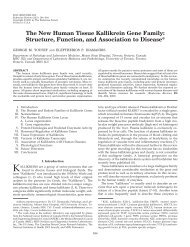The Socio-Economic Importance of Scientific Research To Canada
The Socio-Economic Importance of Scientific Research To Canada
The Socio-Economic Importance of Scientific Research To Canada
Create successful ePaper yourself
Turn your PDF publications into a flip-book with our unique Google optimized e-Paper software.
<strong>The</strong> <strong>Socio</strong>-<strong>Economic</strong> <strong>Importance</strong> <strong>of</strong> <strong>Scientific</strong> <strong>Research</strong> to <strong>Canada</strong> Page 24© David A. Wolfe and Ammon Salterinteraction (Faulkner and Senker 1995). In recent work, Hicks and Katz have shown thatfirms have an increasing tendency to publish (1997). <strong>The</strong> fact that companies publishundermines the informational view <strong>of</strong> economic benefits which suggests that firms areunwilling to codify these aspects <strong>of</strong> their knowledge base for reasons <strong>of</strong> appropriability. Hicksand Katz suggest that firms do indeed publish and they use their published papers to signal thepresence <strong>of</strong> tacit knowledge in the firm (Hicks 1995). Our own investigations intocollaborative research in Ontario supports this finding. Large research–intensive firmsincreasingly view co–publication with academic researchers as an important way <strong>of</strong> signalingtheir firm’s research capabilities to prospective strategic partners in their industry.<strong>The</strong> Pace Study shows that publications remain the most commonly cited source for learningabout public research (Arundel et al. 1995 ). 17 It is necessary to put these results in context.Table 3. <strong>Importance</strong> <strong>of</strong> Different Sources for Learning about Public <strong>Research</strong>Source or Method % Rating as Important High Scoring Industries (scores in percentages)Publications 58 Pharmaceuticals (90), Basic Metals (64), GCC (62),Utilities (61)Informal Contacts 52 Pharmaceuticals (88), GCC (68), Utilities (67),Aerospace (60)Hiring 44 Pharmaceuticals (85), Computers (56), Aerospace(52), Chemical (48)Conferences 44 Pharmaceuticals (85), Utilities (56), Computers (56),Telecom (48)Joint <strong>Research</strong> 40 Aerospace (70), Basic Metals (68), Utilities (67),Pharmaceuticals (51)Contract <strong>Research</strong> 36 Utilities (72), Pharmaceuticals (51), Basic Metals(48), Plastics (46)TemporaryExchanges14 Pharmaceuticals (27), Computers (22), Electrical(20), Basic Metals (20)Note: Respondents were asked to rate the importance <strong>of</strong> each source or method on a 7 point scale. <strong>The</strong>figures indicate the percentage <strong>of</strong> respondents rating each source/method at 5 or higher on that scale.<strong>The</strong> study broke the reponses down to 16 sectors.Source: Arundel et al. 199517 <strong>The</strong> Pace Report, conducted in 1994, involved a mailed questionnaire <strong>of</strong> large firms in the European Union.<strong>The</strong> results, based on 640 responses from 16 sectors received a response rate <strong>of</strong> 56 per cent. <strong>The</strong> sectors includedwere: food, petroleum, chemicals, rubber and plastics, glass, ceramics and cement, basic metals, fabricatedmetals, aerospace, non-electrical machinery, computers, electrical equipment, instrum ents, automobiles, utilities,telecommunications equipment, and pharmaceuticals.24



